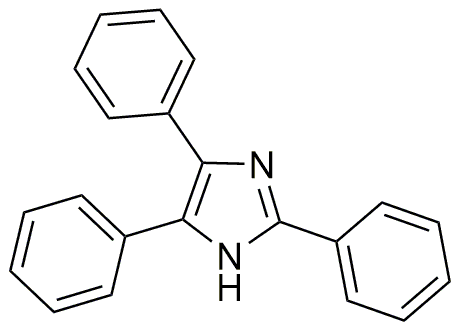2,4,5-Triphenylimidazole is widely utilized in research focused on:
- Photovoltaic Applications: This compound is used in the development of organic solar cells, enhancing their efficiency by acting as a light-absorbing material.
- Chemical Sensors: It serves as a key component in chemical sensors, particularly for detecting environmental pollutants, due to its ability to interact selectively with specific substances.
- Pharmaceutical Development: Researchers leverage its properties in drug formulation, particularly in designing compounds that target specific biological pathways, improving therapeutic efficacy.
- Polymer Chemistry: It is incorporated into polymer matrices to improve thermal stability and mechanical properties, making it valuable in materials science.
- Fluorescent Dyes: The compound is utilized in creating fluorescent dyes for biological imaging, aiding in the visualization of cellular processes in research settings.
General Information
Properties
Safety and Regulations
Applications
2,4,5-Triphenylimidazole is widely utilized in research focused on:
- Photovoltaic Applications: This compound is used in the development of organic solar cells, enhancing their efficiency by acting as a light-absorbing material.
- Chemical Sensors: It serves as a key component in chemical sensors, particularly for detecting environmental pollutants, due to its ability to interact selectively with specific substances.
- Pharmaceutical Development: Researchers leverage its properties in drug formulation, particularly in designing compounds that target specific biological pathways, improving therapeutic efficacy.
- Polymer Chemistry: It is incorporated into polymer matrices to improve thermal stability and mechanical properties, making it valuable in materials science.
- Fluorescent Dyes: The compound is utilized in creating fluorescent dyes for biological imaging, aiding in the visualization of cellular processes in research settings.
Documents
Safety Data Sheets (SDS)
The SDS provides comprehensive safety information on handling, storage, and disposal of the product.
Product Specification (PS)
The PS provides a comprehensive breakdown of the product’s properties, including chemical composition, physical state, purity, and storage requirements. It also details acceptable quality ranges and the product's intended applications.
Certificates of Analysis (COA)
Search for Certificates of Analysis (COA) by entering the products Lot Number. Lot and Batch Numbers can be found on a product’s label following the words ‘Lot’ or ‘Batch’.
*Catalog Number
*Lot Number
Certificates Of Origin (COO)
This COO confirms the country where the product was manufactured, and also details the materials and components used in it and whether it is derived from natural, synthetic, or other specific sources. This certificate may be required for customs, trade, and regulatory compliance.
*Catalog Number
*Lot Number
Safety Data Sheets (SDS)
The SDS provides comprehensive safety information on handling, storage, and disposal of the product.
DownloadProduct Specification (PS)
The PS provides a comprehensive breakdown of the product’s properties, including chemical composition, physical state, purity, and storage requirements. It also details acceptable quality ranges and the product's intended applications.
DownloadCertificates of Analysis (COA)
Search for Certificates of Analysis (COA) by entering the products Lot Number. Lot and Batch Numbers can be found on a product’s label following the words ‘Lot’ or ‘Batch’.
*Catalog Number
*Lot Number
Certificates Of Origin (COO)
This COO confirms the country where the product was manufactured, and also details the materials and components used in it and whether it is derived from natural, synthetic, or other specific sources. This certificate may be required for customs, trade, and regulatory compliance.


